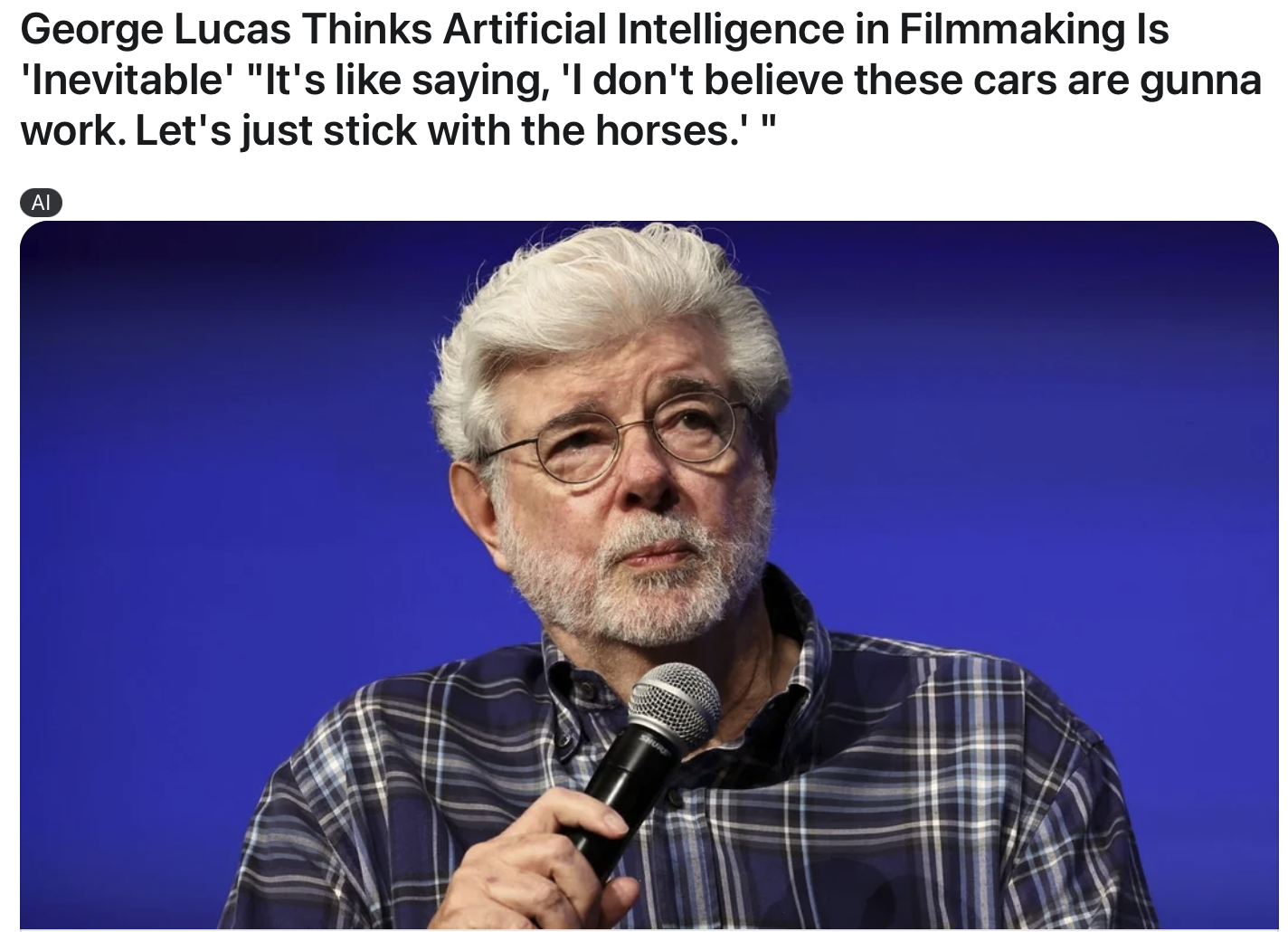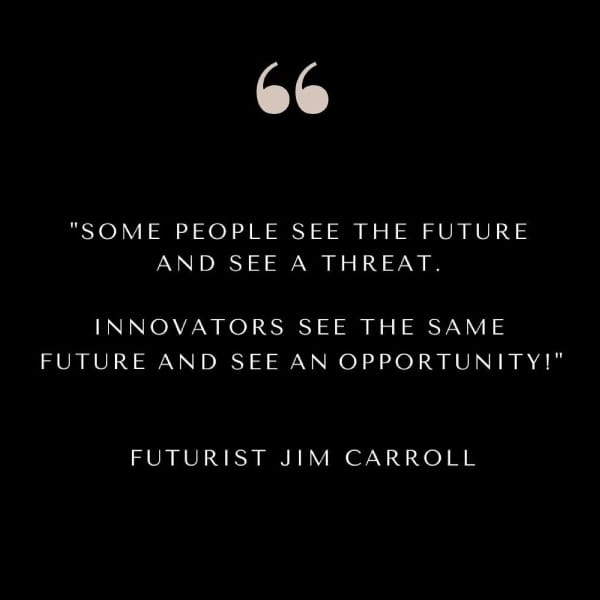"If you aren't amazed by all the amazing trends that are unfolding around you, you're watching the wrong future!" - Futurist Jim Carroll
The future happens fast!
The thing about being a futurist is that you know that certain things are inevitable - much of it just has to do with the timing.
But most BIG trends become VERY REAL at some point and have a massive impact. Here's a thought from George Lucas on what happens as text-to-video AI becomes a very significant and real trend.

With that in mind, here are a few of the major trends I'm watching that have made their way into various keynote presentations in agriculture, healthcare, manufacturing, insurance, retail, and other industries.
- Humanoid robots. This is moving faster than fast! There are dozens of companies coming into this space, and innovation is happening quickly. Some suggest that we will see sub-$15,000 robots available by the end of the year. They will play a role in logistics and warehousing, healthcare and seniors care, building and construction site inspection, and more. Get ready for Rosie the Robot - for real!
- AI-video generation. When George Lucas was busy creating the movies of the future in the 70s and 80s, he realized we were at a serious inflection point with emerging CGI technology - computer-generated graphics - and that it would completely replace the old way of creating complex scenes. The same thing is now happening with text-to-video AI generation. We are about to witness massive disruption in every single aspect of the creative industry, from film to TV, broadcast to digital video production, advertising to marketing. Not to mention the implications for the 'end of reality' as we know it, and what that means for society at large. I'm stunned by the speed and sophistication of what I am seeing online - I have never seen a profound technology evolve this quickly.
- The 'Space Economy.' Years ago, when NASA invited me in for a talk to a room full of astronauts, mission directors, and rocket engineers, I observed that the space industry was set for a massive change. Back then, only the Russians, Chinese, and Americans were involved. Today, Space Inc. involves some 10,000 companies, representing $4 trillion in value ... and only 52% American. We're on the edge of a new disruptive trend involving space-based pharmaceutical discovery, orbital manufacturing, new materials science, and more.
- Digital twin technology. The world of construction, design, manufacturing, healthcare, and more is being virtualized at a furious pace - and yet this often overlooked, fast-moving technology is at the core of much of this change. What is it? We can create a virtual replica of any physical operational space - think of a construction site, complex medical procedure, or manufacturing assembly line - and use this to plan, optimize, organize, and strategize on our real-world implementation plans. This technology is being widely adopted and pushed by the next disruptive generation - today's 30-year-old executive who grew up playing SimCity and FarmVille is now using the same concepts to virtualize construction planning and agriculture.
- Accelerating brain science. What we did for heart health in the 20th century, we are starting to do for brain health in the 21st. The longevity of the baby boomers is leading to a massive spike in Alzheimer's and dementia - while we are living longer, some of us are not living well. We're faced with a $1 trillion spending problem in healthcare to take care of these patients, with few real solutions to manage the complexity it represents. Enter fast-moving brain science technology - how can we use new ideas, methodologies, drug treatments, and more to manage this complex new reality? This is a HUGE growth industry with big implications.
- Regenerative medicine. The folks at Wake Forest University, one of the leading regenerative medicine centers in the world, have adjusted their estimate of when we will be able to grow human body parts for use in human surgery replacements, measuring it in just a few years rather than decades. The world of surgery, rehabilitation, accident management, and more is set to undergo a significant change, as will the insurance and benefits industry that surrounds so much of the healthcare industry. It's not farfetched to believe that we are on the precipice of the era of artificial limbs, organs, eyes, and more.
- Protein folding and AI. Every protein has a shape - and if we can better understand and architect these shapes, we can engineer drugs that fit into those shapes, which can impact how those drugs work. That simplistic summary may not sound like much, but it has a profound impact on drug discovery and development. Recent AI protein-folding models promise a revolution in what we can do with this aspect of science, leading to a sudden and dramatic new acceleration of basic medical science. Not only that but being able to synthesize proteins with a desired structure could speed the development of enzymes to make biofuels and degrade waste plastic - impacting dozens of other industries. We're on the edge of the birth of entirely new industries based on this niche science.
- New material science. Windows that generate solar energy just by being a window. Fibers that breathe and adapt to up-to-the-moment human body conditions. Materials for aircraft and drone construction that are 'lighter than air.' Concrete material with mushroom fiber is being used for 3D printing in concrete on construction sites. There are fascinating new, fast-moving discoveries of thousands of new substances, which lead to disruptive opportunities involving new products and revenue for dozens of industries.
- Vertical farming and the rise of the mega-cities. It's estimated that there will be at least 35 megacities with a population of 35 million or more, by the year 2030. It's not easy to get food into these cities - the logistics are massive. That's why urban centers in Africa and elsewhere are hot on the heels of advances in vertical farming. Imagine skyscrapers full of plants. That’s what begins to happen when the marriage of radical concepts, technology, and a pressing need for innovative thinking collide together to provide for a very BIG trend. It reduces land use by 90 to 99% while vastly increasing productivity from each square meter of land – we can often get 3 to 10 times more crops from the same area. One German vertical farm company reports being able to grow 26 times more wheat in a vertical farm than found with open-field farming! This emerging technology, as it matures, then becomes more widely adopted throughout the wider world.
- Longevity technology. Quite simply, accelerating medical science, precision medicine, DNA-based healthcare and more are leading to the longevity revolution - we are truly learning how to slow the inevitable process of aging. This has profound implications for families, societies, and nations. What happens when a 6-generation family becomes routine?
The interesting thing is that all of these trends - and many of the other ones I'm continuously tracking and researching - have profound impacts on every industry, from healthcare to retail, manufacturing to insurance. That's why, as you know, one of my go-to stage phrases is this: "Companies that don’t yet exist will build products that are not yet conceived, based on ideas that have yet been generated, using materials not yet invented, with manufacturing methods that have not yet been conceived. Are you ready for the new world of disruption?”
That idea is the essence of disruption and is the essence of what is the focus of my many corporate keynotes - and that's why I feature this tagline on my home page.

Do you see the future as a threat?
Or do you see it as an opportunity?
Are you looking at the 'right stuff?'
Your answer matters.
Futurist Jim Carroll is continuously watching many trends. It's in his job description.

